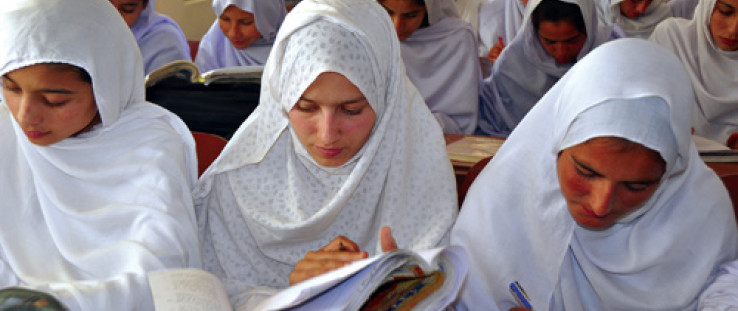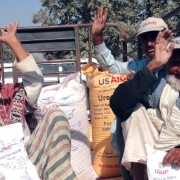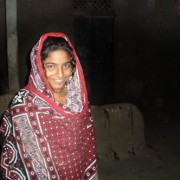 More than 500 girls from Rerra and neighboring villages study at a USAIDsponsored school in Pakistan.
Virginija Morgan/USAID
More than 500 girls from Rerra and neighboring villages study at a USAIDsponsored school in Pakistan.
Virginija Morgan/USAID
 More than 500 girls from Rerra and neighboring villages study at a USAIDsponsored school in Pakistan.
Virginija Morgan/USAID
More than 500 girls from Rerra and neighboring villages study at a USAIDsponsored school in Pakistan.
Virginija Morgan/USAID
BAGH, Pakistan—"I was standing by the bank of elevators at the USAID office in Washington," says Bob MacLeod, remembering how he was recruited to come to Islamabad. "The earthquake had just hit Pakistan, and USAID's mission director for Pakistan, Mark Ward, asked me if I had a visa."
Five years later, MacLeod is making his last visits to the schools and basic health units he saw being constructed by USAID throughout earthquake-destroyed areas of Kashmir in northeastern Pakistan.
"Thank you Bob for the school you helped build," says a handmade banner one of the communities sent him, and MacLeod is quick to respond that it was a joint effort by the USAID team, the contractor, and the local people.
While Pakistan's massive summer 2010 flooding has shifted attention away from the similarly devastating earthquake, that catastrophe has not been forgotten.
MacLeod arrived in the country on Oct. 22, 2005, two weeks after the earthquake struck Pakistan's then North-West Frontier province and Kashmir, claiming 74,000 lives and leaving more than 2.8 million people homeless.
"In one community, 130 girls were killed at a girls' college," says MacLeod. "Their dead bodies were still there when we visited the site."
Within a month, USAID's mission in Pakistan presented a strategy that mapped out reconstruction efforts.
Four, five-year projects launched in 2006 with a budget of $256 million. The projects keyed in on restoration of livelihoods, support for education and health systems, and reconstruction of schools and health-care facilities.
MacLeod was assigned to manage USAID's Pakistan Earthquake Reconstruction and Recovery Program that focused on rebuilding key social infrastructure in affected communities.
Over the next five years, the program helped build or rehabilitate 74 primary, middle, and high schools for thousands of girls and boys across Kashmir and in Mansehra in Khyber Pakhtunkwa province. Basic health units were constructed and 20 more schools and one 40-bed hospital would be built as well.
"But the best achievement is the engagement of local communities, teachers, and farmers in our work," says MacLeod, "because this project belongs to them."
Each school and health-care facility was designed by Pakistani firms in cooperation with an American construction company that is carrying out the project for USAID.
All the buildings now have large windows that flood the rooms with sunlight—and minimize the use of electricity. The roofs are pitched to meet international building codes and guidelines for earthquake-prone areas. USAID also ensured that schools and health-care facilities have access for the disabled, an unusual approach for Pakistan.
The designs proved popular among local communities, and now the Pakistan government is financing construction of similar schools in earthquake-affected areas in the north of the country.
"We are grateful to the American people for helping us erect this beautiful building that will serve our community for the years to come," says Mahmood Sadiq Khan, chairman of the school management committee, a volunteer school support group that USAID helped organize for the girls' college in Rerra Town, Bagh District.
Each USAID-built facility incorporated an activist committee to make decisions, communicate with local residents, and raise community donations to support the construction. In Rerra, residents donated land for construction crew offices, and supplied electricity and water for the construction free of charge.
Yet to MacLeod, the most valuable contribution by the committee was to solve all local issues related to the building process, so that only eight days of construction time were lost to any conflict, which often happens in Pakistan. Now that the schools are operating, the committee is raising donations for the school library and working to design co-curricular activities, such as sports classes.
"I am pleased that my three granddaughters can study within their own community," says Sadiq Khan with a proud smile on his face.
Rerra's girls' intermediary college teaches 511 students today, more than a 100-student increase since before the earthquake, and plans to reach 1,000 students within the next five years. The school hopes to receive status as a degree-granting college soon, and has 60 students waiting to attend college-level classes, so that girls in the neighboring communities can continue their studies.
"Five years is a long time to rebuild, but it's the only way to go if we want to rebuild better than it was, so no community has to lose their children to an earthquake again," says MacLeod.










Comment
Make a general inquiry or suggest an improvement.